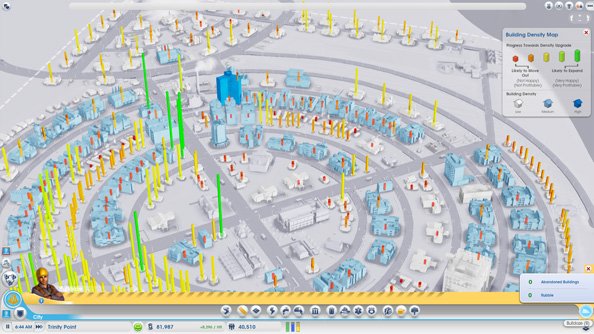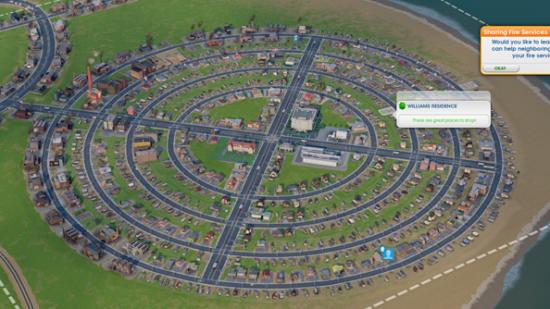Hello, I am the best SimCity mayor. Above you’ll see a screenshot of the best city, my city, ‘Lovely City’, which has drawn upon centuries of urban planning and design theory to arrive at the most ruthlessly efficient and aesthetically arousing city layout possible. Science agrees. Actual mayors have torn up their mayoral rulebooks in disgust. By arranging all roads in concentric circles emanating from a central point, my citizens boast easy access to their workplaces, preferred commercial vendors and homes by means of travel along diametral avenues and the pristine circumferences of one of a series of ever-widening ring-roads. It’s perfect. It looks like a big target too, which is ideal if you’re aiming to shoot the best mayor with an arrow, because my house is right in the middle.
In truth, Lovely City didn’t work out as well as I’d hoped. I played SimCity for six hours, creating a handful of cities in my time with the game, and Lovely City was perhaps the worst of the bunch. It had traffic problems stemming from the haphazard zoning of my residential, industrial and commercial zones, with citizens having to share roads with freight and other traffic just to get to and from work. I’d allocated a dirty, off-circle corner of the map for all of my polluting industrial buildings to do their stuff. This is also where I placed my sewage outflow pipes, which would quite simply pump sewage into a big mucky field downwind of the rest of Lovely City.
I hadn’t anticipated other transport problems. As my population grew I unlocked additional modules to bolt on to City Hall, which in turn unlocked new tourist attractionsand famous landmarks. I plopped (plop being the official terminology for placing buildings in SimCity) an Expo Centre next to the city’s main rail connection, but later discovered that my local airport could only fit in the far flung industrial wasteland I’d created, which not only meant that tourists stank of piss by the time they reached the geometric curves of Lovely City, but that they’d arrive late to the events taking place there. This put the expensive Expo Centre at risk of running at a loss. (Not only that, but the events I threw, such as the Motocross event, only attracted low to middle income citizens, whereas airports tend to be used more by the upper class. To attract those rich folk I’d need to build a stadium and throw some sort of fancy shindig, like a Haute Couture Con or Monocle Fest).
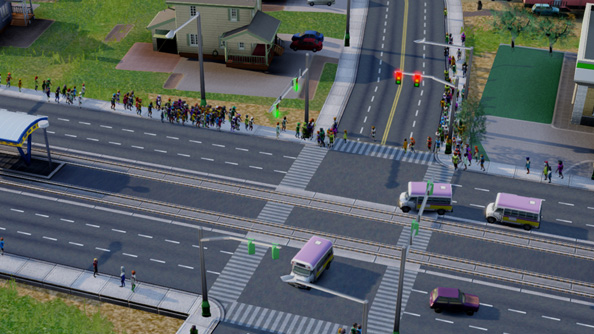
Transport elbows its way to the top of your city’s list of priorities nowthat it’s the one financial stumbling block that prevents you immediately spreading out into and filling the tiny space each city map affords you. Roads come in two types, streets and avenues, which allow low volumes and high volumes of traffic respectively. Streets and avenues then come in low, medium and high densities, which effect the densities of the buildings that are constructed along them. That is to say: roads, and not the zones themselves, now define how your city looks. To get skyscrapers you must upgrade roads to their highest densities (which is expensive to do), ensure the land is sufficiently valuable by building lots of parks and have appropriately wealthy citizens move in.
Drawing roads is itself made simpler by a clever guidance system. This dotted line shows you exactly where to build roads in order to maximise the use of the spaces left between them, so that the residential, commercial or industrial buildings inside them are flush and neat and able to expand where they need to. Follow them carefully (they even work with your freehand roads) and you’ll get densely packed, greebled Manhattan cityscapes. Ignore them and you’ll have something patchier and more natural in appearance, which is just dandy if you love doing things wrong. I used the guides to place Lovely City’s great circular roads, as even a few metres of inaccuracy there would’ve prevented entire blocks from increasing in size. Zones need space to expand, and if it’s not available your advisor will tut about it endlessly until you start bulldozing roads.
If you draw roads freehand and then begin to follow the guides the game suggests, you can create some interesting looking cities. The one below was built on a multiplayer map. The player in the city next to mine could angle his camera towards the horizon and observe my city’s skyline from afar. Which was nice.
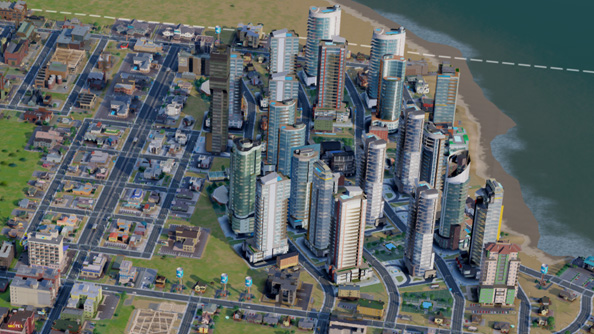
While your sims will build their own houses and shops and factories, it’s up to you to plop down fire stations, schools, clinics, police stations and other services. These can all be upgraded, so you could add an extra garage to a police station to give it one more patrol car. Or stick a bell on top of a fire station to give it a slight speed boost when responding to fires. Schools can have additional classrooms bolted on to them to increase their capacity, and school bus stops can be placed around residential areas to collect kids. Education improves an area, reducing crime, increasing wealth and unlocking certain kinds of technology for use in industry.
You can find oil reserves and build entire cities focused on sucking it up and refining it into plastics or fuels, and then either using that fuel to power a city locally, sell to a neighbouring city in your region or sell on the global market, which fluctuates depending on actual supply and demand from real players. Your citizens commute between cities in a region too, with better educated sims going to work in wealthier industrial areas depending on how robust a transport infrastructure you’ve made. If your neighbouring city has decided to specialise in education, for example, you can deprioritise building schools in your oil-harvesting town as long as your citizens can safely and quickly commute to universities. You’re not dependent on other players either, as you can control and rule over every city in a region manually.
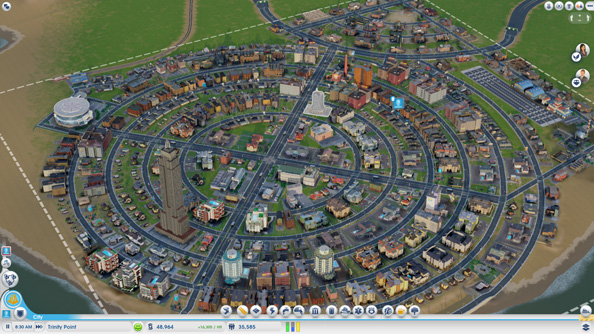
The problem is, with cities this miniature, you’ll have to farm out some responsibility to other cities if you decide to specialise. The city limits you see in the above screenshot are fixed —that’s the largest any city in SimCity can become — which presents some interesting challenges at the expense of any onecity’s locallongevity and freedom. Maxis promise you can build a thriving city within the postage stamp they’re offering, and there’s definitely some mayoral intellect required in deciding which districts to bulldoze in order to build a fancy new hospital, but it never feels like a necessary compromise when the edges of your city are so arbitrarily claustrophobic.What is this, a SimCity for SimAnts?Cities need to beat leastthree times this big.
This restriction makes a little more sensewhen youplay multiple gamesacross regions that support up to 16 cities. Cities stop “simming” when you’re not playing them, and instead offer automated background support and services to their neighbours, so it’s simple enough to split your region into different complementary city types. Working together with yourself orother mayors allows you to progress towards constructing a region’s Great Work, an end-game goal that’scurrently either an international airport, a space station, giantsolar farm or Arcology.
Unlocking these requires certain volumes of shared wealth,materials and commodities, such as space rocket fuel and clever people to sit inside rockets. That makes SimCity a bit like a crafting game, beginning with grade schools and tar pits and ending with scientists and petrol. Or casinos and criminals, or shopping centres and stadia. Whatever target you set yourself.
SimCity is a deep simulation crawling with individually modelled citizens, dinkycars with destinations and homes, intercitycommuters and entire volumes of urban planning guides built into every meticulously modelled, toytownjunction. After justa few hours with it you’ll begin to literally and figurativelybump up against the edges of what’s possible within the mayorship of a single city played privately, at which point it seems the bestway to progress is to either embrace SimCity’s global community and begin inviting other players into your region and taking on Maxis-mandated weeklychallenges, or to attempt ever stranger and more ambitiouscity designs around some of the more extreme terrain on offer.
Or to draw a giant ego-appeasing target with your house in the middle of it. That’s also fun. Either way, SimCity feels like a game that spreads outwards rather than upwards, showing you its whole deck within the first rapidhandful of city builds before asking you to shuffle and play again online. We’ll know if that trick works once it arrives in March.
Oh, and it also features the most beautiful real-timedata visualisations in games:
